Modeler’s Biography: Ralph Buckwalter has been a member of the Rocky Mountain Shipwrights since 1992 and has competed in the Manitowoc Maritime Museum model show and competition for approximately 15 years. Ralph is a retired Mechanical Engineer.
Category Archives: Ralph Buckwalter
Atlantic Luxury Yacht
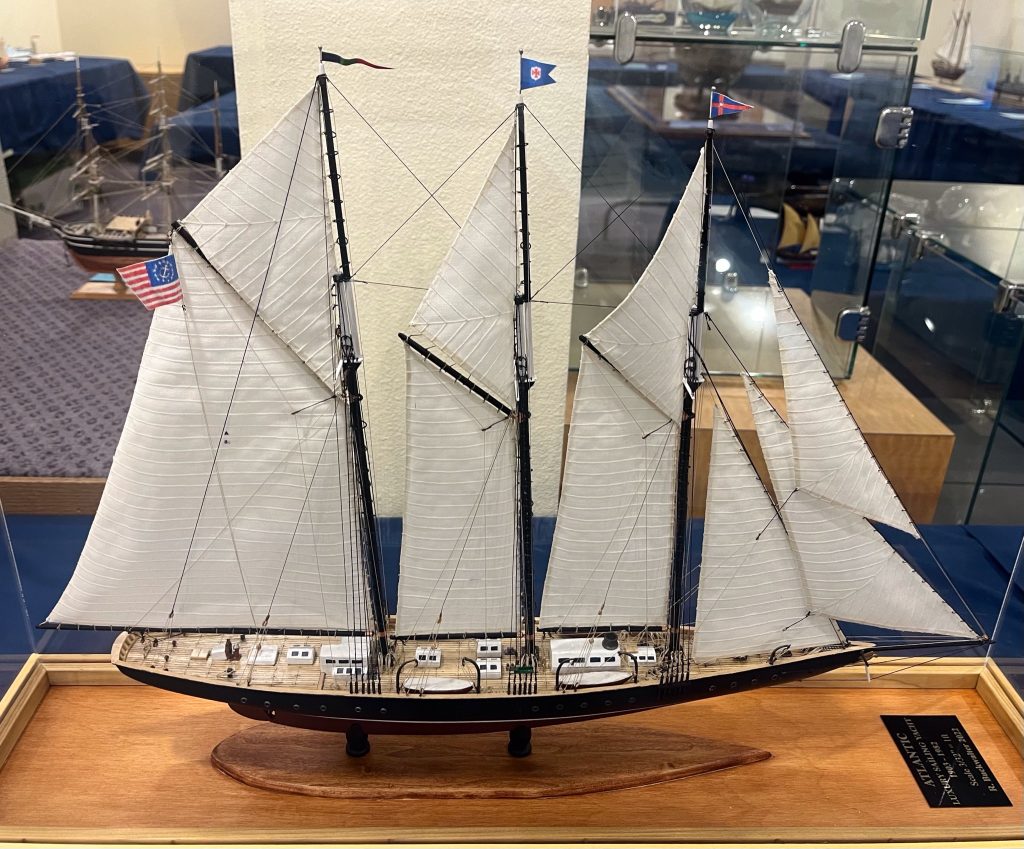
Period Ship Sailed: 1903 – 1982
Type of Model: Scratch built using the bread and butter lift method
Build Time: One year
Scale: 3”/32’
Description of build: The plans for the model were from Bluejacket’s kit of the Atlantic. The hull is popular, the rigging is black for the standing rigging and tan for the running rigging. The sails are hand made from a light muslin material.
Ship’s History: The Atlantic was a luxury yacht built for the millionaire Wilson Marshall. Marshall raced her under the auspices of the New York Yacht club. She was the largest private yacht of her day with an overall length of 227’ 8” displacing 303 tonnes. She was launched in 1903 and scrapped in 1982. She set a record for the transatlantic race in 1905 sailing 3,006 miles in 4 hours, 1 minute, and 19 seconds which lasted until 1988. She served in both World War 1, in the US Navy and World War 2 in the Coast Guard.
Fergus
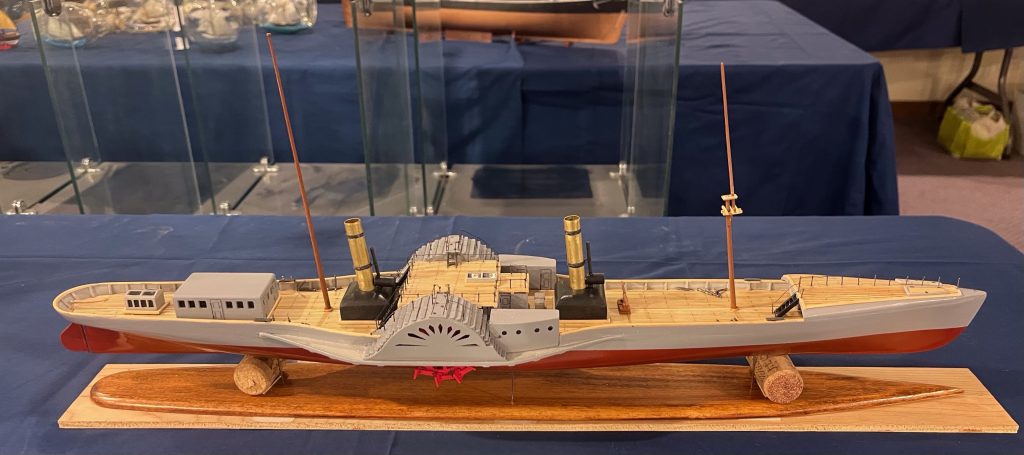
Period Ship Sailed: Civil war
Type of Model: Scratch-built based on the builders’ plans from the US National Museum, Smithsonian Institution in June 1959.
Build Time: Under construction
Scale: 3”/32’
Description of build: This is a multiple lift construction “Bread and Butter” for the hull. The hull is —wood and the deck furniture is basswood. This vessel with steam and sail power. The steam drives side paddle wheels which are articulating, which means the paddles rotate as the wheel rotates, which improves the efficiency and speed. The vessel is 217.5 feet long, 23 feet wide with a very shallow draft of 4 feet.
Ship’s History: Fergus, aka Presto, was built by Alex Stephens and Sons in Glascow Scotland on the river Clyde and launched on August 1, 1803. She had an all-steel riveted hull. She sailed from Glasgow to the U.S. due to the limited amount of coal for her boilers for such a long trip. Her narrow hull and shallow draft and steam and sail power made a perfect vessel to run the blockades of the North. However, on her second run went aground on Sullivan’s Island at the entrance to Charleston Harbor and was destroyed by shell fire from the Union Fort on Morris Island.
L’Hermione
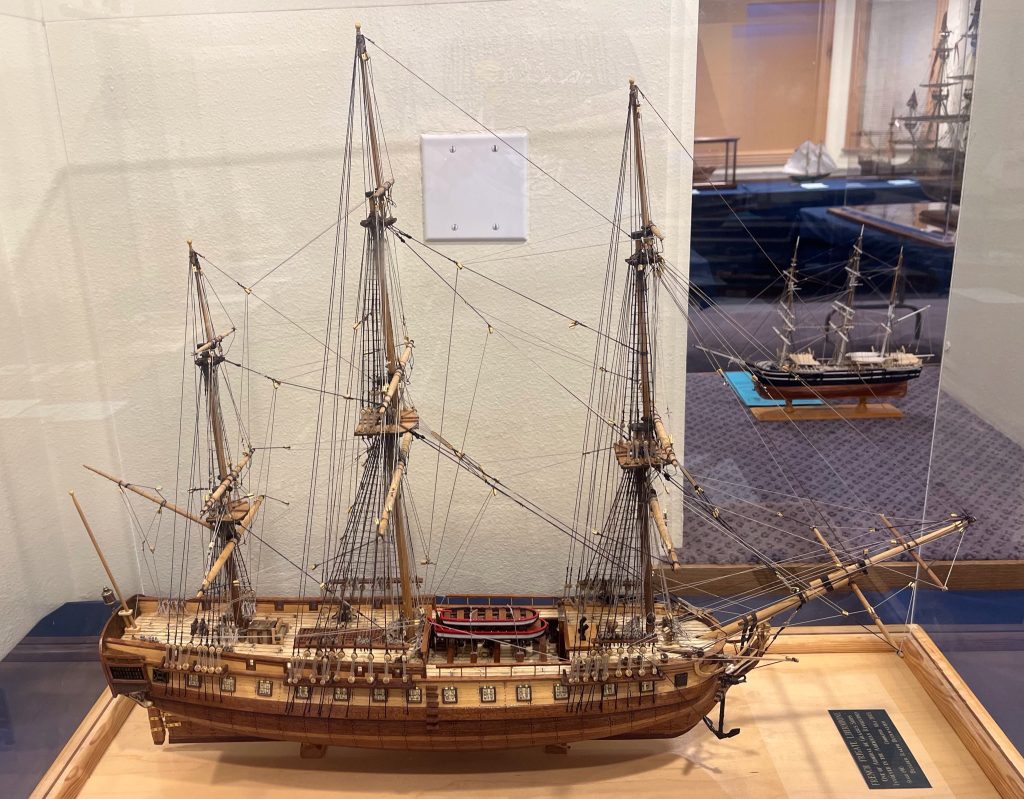
Modeler’s Name: Ralph Buckwalter
Period Ship Sailed: 1773 – 2014
Type of Model: Wooden plank on bulwark kit
Build Time: 13 months
Scale:
Description of build: This model is based on plans used in the reconstruction of a full-sized replica which was completed in 2014 in the same Rochefort Arsenal as the original. This replica visited the United States during a world tour.
Ship’s History: L’Hermione transported he Marquis de Lafayette to join the American revolution on March 21, 1780. She was built at the Rochefort Arsenal in 1778. L’Hermione was a French 32-gun light Frigate, 214.5 feet long, rated at 1,200 tons, and carried over 16,335 sq. ft. of sails on three masts. She carried 32 cannons, twenty-six 12-pounders, and six 6-pounders. L’Hermione was involved in two battles in Chesapeake Bay and at the Battle of Yorktown. She left American waters on February 2, 1782, returning to France.
Lizzie Metzner
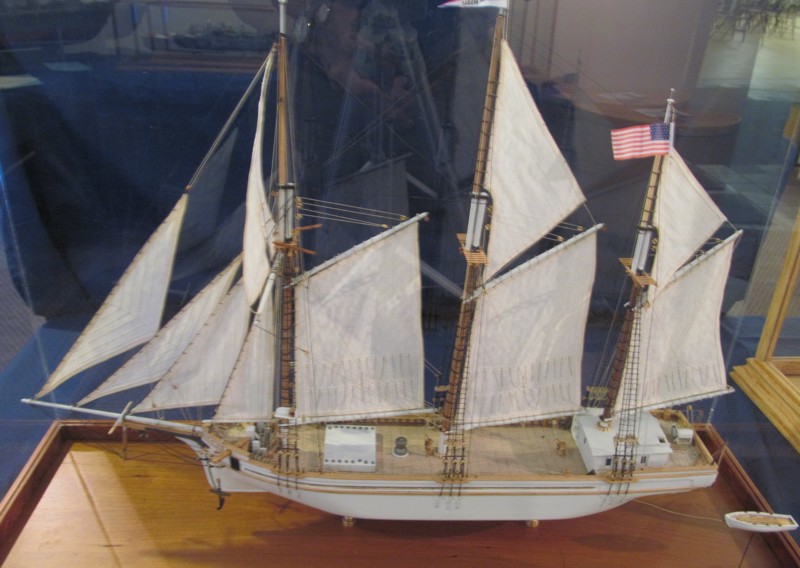
Modeler’s Name: Ralph Buckwalter
Period: 1888
Scale: 7/64 in. per ft.
Type of Model: scratch built solid hull
Build Time: not estimated
Build Materials:
No plans were available for this ship. Based on the plans for a similar ship which was 46 ft longer than the Lizzie I reduced the plans so the overall length was equivalent to the 81 ft of the Luzzie. I built the hull based on these plans modifying the hull based on the photos I had of the Lizzie. . The hull was done using the bread and butter method which consists of multiple thin lifts of wood cut to lines taken from the plans . I was intrigued by the triangular sail on the fore mast. I sewed all of the sails and bent them on as shown in the photos.
Ship’s Story:
The Lizzie Metzner was a typical Great Lakes Schooner which was used to carry various cargos on the great lakes. She was built in 1888 Rand and Burger in Manitowoc Wisc. for the firm of Mashek and Metzner of Kewaunee Wisc., who owned the south pier in Manitowoc. Wisc. The Lizzie Metzner was 81 ft. in length, had a beam of 21ft 8 in. and a depth of 6ft 9 in. Her gross tonnage was 77. She was built from blue oak and cost $1200 when delivered. The Lizzie Mitzner had a shallow draft,less than 3 ft.,and had a centerboard that could be used to take advantage of this shallow draft. She had a Raffee sail, a triangular top sail, on the foremast. These Raffee sails were the trademark of many Great Lake schooners.
Modeler’s Bio:
Ralph Buckwalter, a retired Mechanical Engineer has been modeling for about 14 years. He joined the Rocky Mountain Shipwrights in 2000. His first model was a pirate ship.
Le Hussard
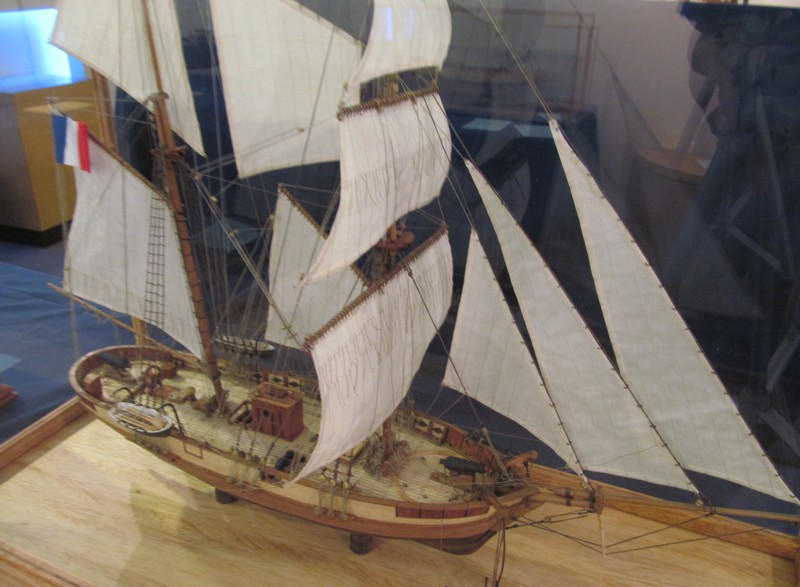
Modeler’s Name: Ralph Buckwalter
Period: 1845
Scale: ¼” = 1’
Type of Model: modified plank on bulkhead kit
Build Time: not estimated
Build Materials:
Build Materials: This model was built from an Artesania Latina kit that has been modified to more closely represent the description listed in the “Global Schooner”. I also used some information from “Souvenirs De Marine” by Admiral Paris which had better details than those of the kit. This included rigging and deck furniture. All sails were hand machine sewn and not the ones supplied with the kit. I also used a product named “Quicken” to stiffen and shape the sails.
Ship’s Story:
Le Hussard is identified as a French Brigantine built in 1845 in the kit, although she is described in the “Global Schooner” by Karl Heinz as a French Schooner. She was larger than her American and British counterparts. She has the following measurements: L – 98’ 6”, W – 27’ 11”, Depth in hold 9’ 2”. Her main feature was her armament. She carried two rotating carronades, 18 pounders, one in the bow and one in the stern. These rotating carronades were supposed to make Le Hussard a foe to fear but I don’t think this was the case. The bow panels would drop down so the carronade could be aimed at vessels low in the water close to the ship.
Modeler’s Bio:
Ralph Buckwalter, a retired Mechanical Engineer has been modeling for about 14 years. He joined the Rocky Mountain Shipwrights in 2000. His first model was a pirate ship, Black Falcon
